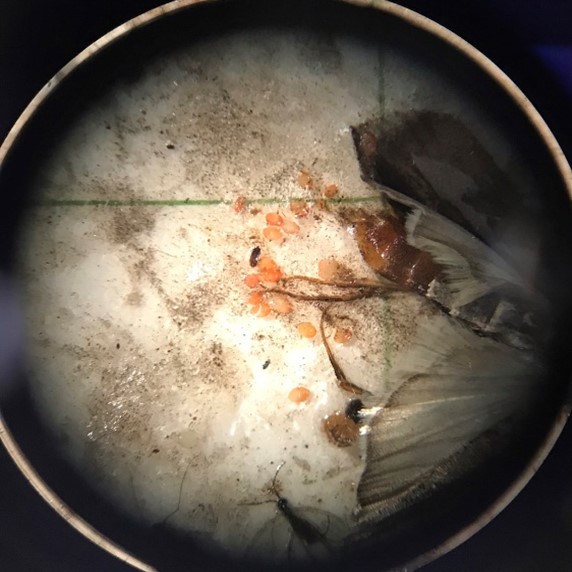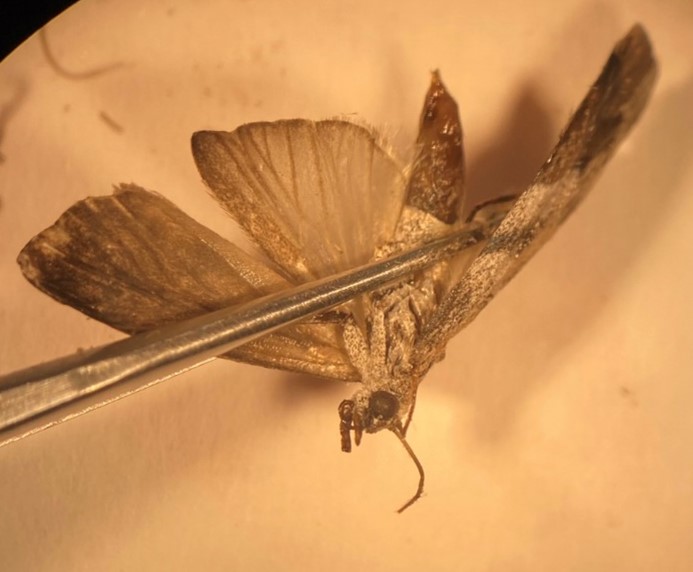
Navel Orangeworm Program
Integrated Pest Control Branch • 916-262-1102 • ipcinfo@cdfa.ca.gov
The Navel Orangeworm (NOW) Program is a cooperative project between the California Department of Food and Agriculture’s (CDFA) Integrated Pest Control Branch, the United States Department of Agriculture’s (USDA) Animal and Plant Health Inspection Service (APHIS) and Plant Protection and Quarantine (PPQ), and the California tree nut industry. The goal of the NOW Program is to develop an area-wide integrated pest management program that incorporates sterile insect technique (SIT), good sanitation practices, mating disruption, trap monitoring, and chemical applications to help reduce damage caused by NOW populations in California. The NOW Program currently implements SIT in congruence with pheromone/PPO trap monitoring in select almond and pistachio orchards in the San Joaquin valley. Trap monitoring is conducted year-round within all zones and daily aerial NOW SIT releases are typically conducted during the months of March to October. Growers are encouraged to participate in the NOW Program.
Navel Orangeworm Program Reports and Maps
2021
2022
- Weekly Report - 01/28/2022
- Weekly Report - 02/18/2022
- Weekly Report - 02/25/2022
- Weekly Report - 03/04/2022
- Weekly Report - 03/11/2022
- Weekly Report - 03/18/2022
- Weekly Report - 03/25/2022
- Weekly Report - 04/08/2022
- Weekly Report - 04/15/2022
- Weekly Report - 04/22/2022
- Weekly Report - 04/29/2022
- Weekly Report - 05/13/2022
- Weekly Report - 05/27/2022
- Weekly Report - 06/10/2022
- Weekly Report - 06/24/2022
- Weekly Report - 07/8/2022
- Weekly Report - 07/29/2022
- Weekly Report - 08/19/2022
- Weekly Report - 09/09/2022
- Weekly Report - 09/23/2022
- Weekly Report - 10/14/2022
- Weekly Report - 11/4/2022
- Weekly Report - 11/25/2022
- Weekly Report - 12/23/2022
2023
- Weekly Report - 2/17/2023
- Weekly Report - 2/24/2023
- Weekly Report - 3/3/2023
- Weekly Report - 3/10/2023
- Weekly Report - 3/17/2023
- Weekly Report - 3/24/2023
- Weekly Report - 3/31/2023
- Weekly Report - 4/7/2023
- Weekly Report - 4/14/2023
- Weekly Report - 4/21/2023
- Weekly Report - 4/28/2023
- Weekly Report - 5/5/2023
- Weekly Report - 5/12/2023
- Weekly Report - 5/19/2023
- Weekly Report - 5/26/2023
- Weekly Report - 6/2/2023
- Weekly Report - 6/9/2023
- Weekly Report - 6/16/2023
- Weekly Report - 6/30/2023
- Weekly Report - 7/14/2023
- Weekly Report - 7/28/2023
- Weekly Report - 8/4/2023
- Weekly Report - 8/11/2023
- Weekly Report - 8/18/2023
- Weekly Report - 8/25/2023
- Weekly Report - 9/1/2023
- Weekly Report - 9/8/2023
- Weekly Report - 9/15/2023
- Weekly Report - 9/22/2023
- Weekly Report - 9/29/2023
- Weekly Report - 10/6/2023
- Weekly Report - 10/13/2023
- Weekly Report - 10/20/2023
- Weekly Report - 11/3/2023
- Weekly Report - 11/24/2023
- Weekly Report - 12/1/2023
- Weekly Report - 12/8/2023
- Weekly Report - 12/29/2023
2024
- Weekly Report - 1/12/2024
- Weekly Report - 1/19/2024
- Weekly Report - 2/2/2024
- Weekly Report - 2/16/2024
- Weekly Report - 2/23/2024
- Weekly Report - 3/1/2024
- Weekly Report - 3/8/2024
- Weekly Report - 3/15/2024
- Weekly Report - 3/22/2024
- Weekly Report - 3/29/2024
- Weekly Report - 4/5/2024
- Weekly Report - 4/12/2024
- Weekly Report - 4/19/2024
- Weekly Report - 4/26/2024
- Weekly Report - 5/3/2024
- Weekly Report - 5/10/2024
- Weekly Report - 5/17/2024
- Weekly Report - 5/24/2024
- Weekly Report - 5/31/2024
- Weekly Report - 6/7/2024
- Weekly Report - 6/14/2024
- Weekly Report - 6/21/2024
- Weekly Report - 6/28/2024
- Weekly Report - 7/5/2024
- Weekly Report - 7/12/2024
- Weekly Report - 7/19/2024
- Weekly Report - 7/26/2024
- Weekly Report - 8/2/2024
- Weekly Report - 8/9/2024
- Weekly Report - 8/16/2024
- Weekly Report - 8/23/2024
- Weekly Report - 8/30/2024
- Weekly Report - 9/6/2024
- Weekly Report - 9/13/2024
- Weekly Report - 9/20/2024
- Weekly Report - 9/27/2024
- Weekly Report - 10/4/2024
- Weekly Report - 10/11/2024
- Weekly Report - 10/18/2024
- Weekly Report - 10/25/2024
- Weekly Report - 11/1/2024
- Weekly Report - 11/8/2024
- Weekly Report - 11/15/2024
- Weekly Report - 11/22/2024
- Weekly Report - 11/29/2024
- Weekly Report - 12/6/2024
- Weekly Report - 12/13/2024
- Weekly Report - 12/20/2024
- Weekly Report - 12/27/2024
- Weekly Report - 1/3/2025
- Weekly Report - 1/10/2025
- Weekly Report - 1/17/2025
- Weekly Report - 1/24/2025
- Weekly Report - 1/31/2025
- Weekly Report - 2/7/2025
- Weekly Report - 2/14/2025
- Weekly Report - 2/21/2025
- Weekly Report - 2/28/2025
- Weekly Report - 3/7/2025
- Weekly Report - 3/14/2025
- Weekly Report - 3/21/2025
- Weekly Report - 3/28/2025
- Weekly Report - 4/4/2025
- Weekly Report - 4/11/2025
- Weekly Report - 4/18/2025
- Weekly Report - 4/25/2025
- Weekly Report - 5/2/2025
- Weekly Report - 5/16/2025
- Weekly Report - 5/30/2025
- Weekly Report - 6/6/2025
- Weekly Report - 6/13/2025
- Weekly Report - 6/20/2025
- Weekly Report - 6/27/2025
- Weekly Report - 7/4/2025
Navel Orangeworm Impact, Biology, and Identification
Navel orangeworm, Amyelois transitella, affects a wide range of California’s fruit and nut crops each year, including citrus, dates, figs, pomegranates, almonds, pistachios, walnuts, and more. California’s climate supports a continuous breeding population of NOW, which makes it likely that NOW will continue to expand its area and impact on tree nut crops and other susceptible hosts. Tolerance to pest damage by NOW is extremely low given the relationship between NOW damage and aflatoxin, ansd the low tolerance for insect damage in export markets. Given the vast acreage of tree nut crops and susceptible hosts in California, controlling and suppressing NOW populations would require a massive, coordinated effort by industry, state, and federal levels.
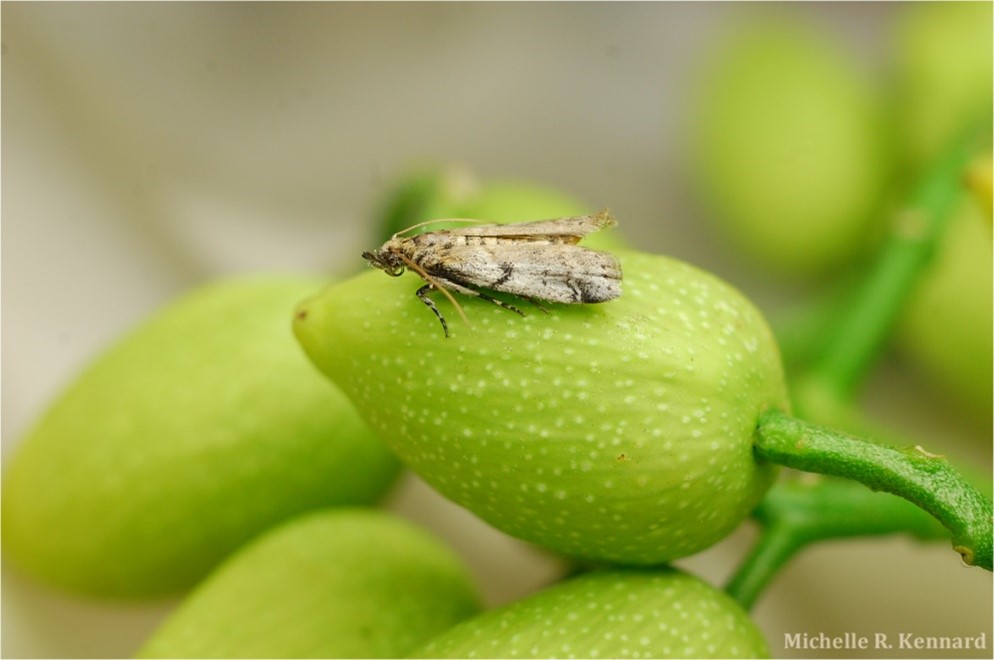
Adult NOW moth |
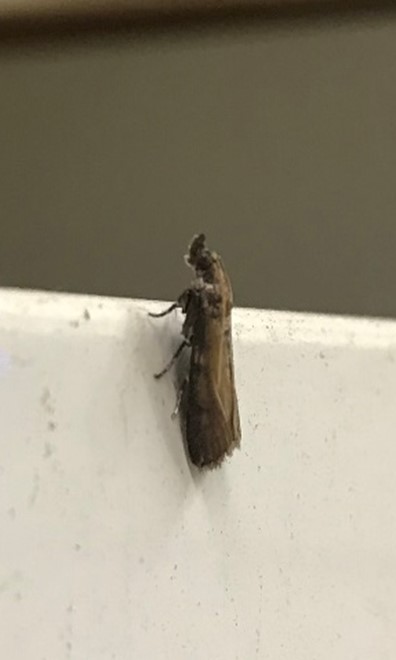
Adult NOW moth |
NOW first emerge each spring from the leftover, or "mummy," nuts or fruit from the previous harvest season (Palumbo et al, 2014). Shortly after emerging, the NOW female moths will oviposit in available nut and fruit hosts, usually within two days after mating. During this first emergence, or flight, female moths will primarily oviposit in mummy nuts or fruit, while later flights will see more oviposition in new crops. There are usually 3 or 4 flights each year. After harvest, any remaining fruits or nuts are available hosts for the moths to deposit their eggs. Eggs will remain in the mummy nuts over the winter season and hatch when temperatures are adequate. In the lower San Joaquin Valley, for example, this could be as early as March, depending on how many degree days have accumulated. Degree days are accumulated when temperatures fall between 55° and 94° F (UC IPM Website).
After oviposition, the eggs will hatch into larvae after as little as 56 degree days have accumulated (Wilson et al, 2020). Depending on the quality of the host and daily temperatures, this could vary between a few days to weeks. Upon hatching, the larvae will feed on the surrounding meal or fruit in order to grow and reach maturation. The larvae then undergo pupation until enough degree days have accumulated for emergence to occur. This can be anywhere between 424 to 623 degree days, depending on whether the host is a new crop or a remainder from the previous harvest season.
NOW larvae undergo several molts, or growth stages, before reaching maturity, and can grow up to ¾ of an inch in length (Bentley et al, 2008). Their color ranges from cream to red orange, depending on their diet, with a black crescent marking near the head on both sides.
NOW moths are usually between ½” to 1” in length with varying patterns of grey, black, and brown on their forewings. They are often identified by their palps that form a “snout-like” protrusion at the top of their heads.
Program Details
NOW SIT is a form of mating disruption in which sterile moths are introduced into wild populations so that when the sterile moths mate with the wild moths no viable offspring are produced. During the SIT season (typically March through October) CDFA receives daily shipments of NOW SIT moths from USDA’s rearing facility in Phoenix, Arizona. These sterile moths are loaded onto an aircraft and released over designated sites of almond and pistachio orchards. CDFA conducts Quality Control (QC) tests on a sampling of moths from every shipment prior to aerial release to monitor the viability and fitness of the sterile moths.
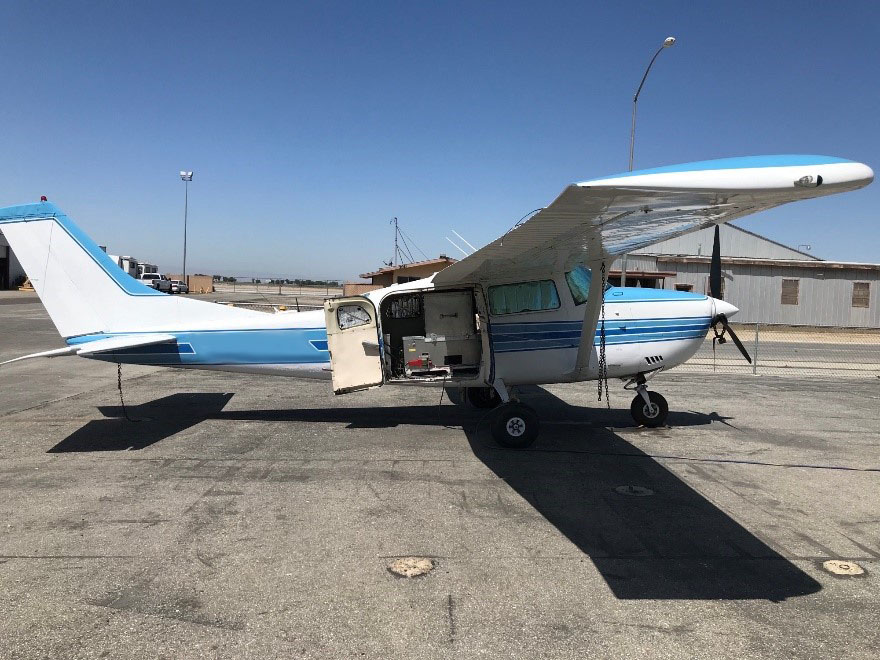 Aerial release plane |
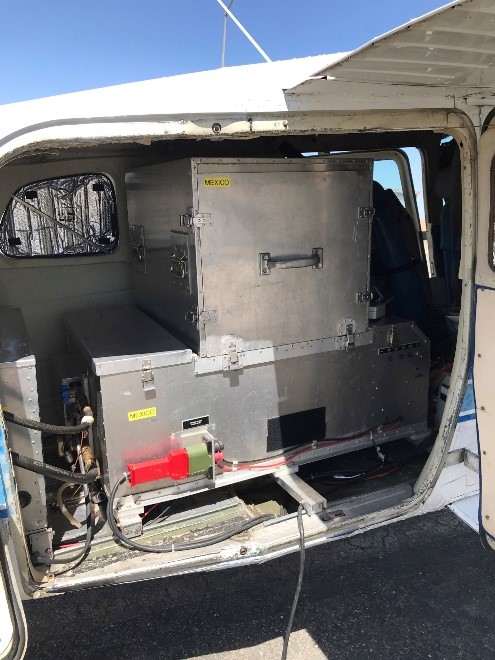 Release components |
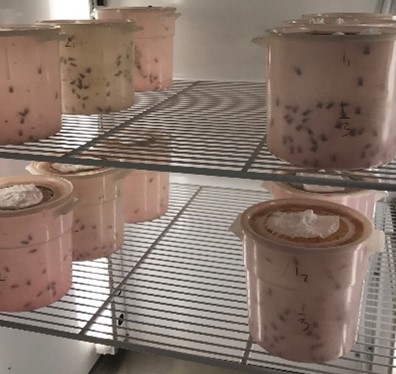
Quality control samples |
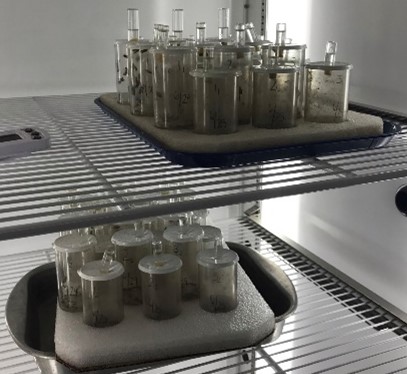
Quality control samples |
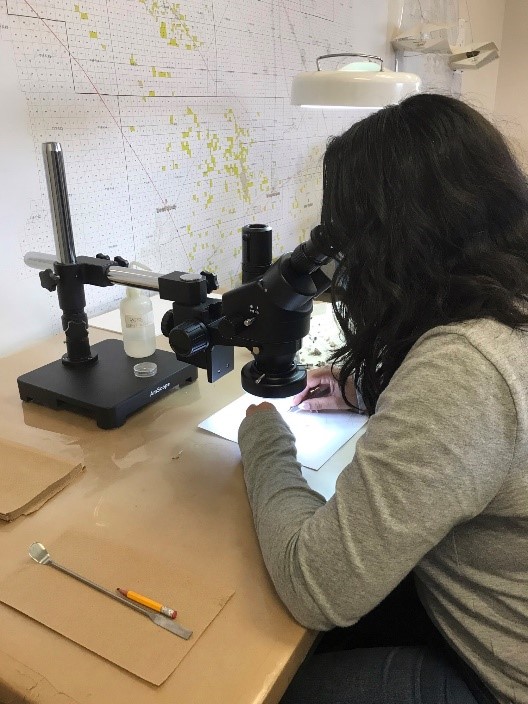
Laboratory processing |
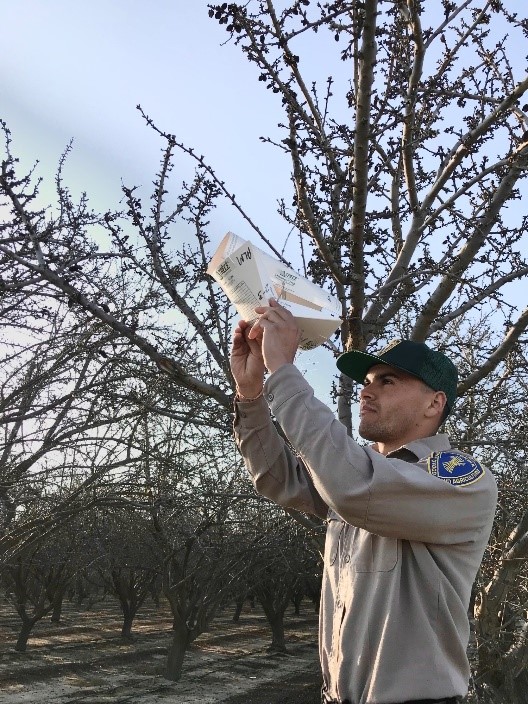
Trap servicing
The NOW Program conducts trap monitoring year-round using pheromone/PPO and pistachio meal-baited wing traps to monitor wild NOW populations as well as recapture SIT NOW moths. The pheromone traps release a scent mimicking the female moth, which attracts nearby male moths. Since female NOW moths tend to deposit their eggs in susceptible nut hosts, such as pistachios, the pistachio meal traps are used to attract the female NOW moths. The trap bottoms contain a sticky residue and are collected each week, with new trap bottoms replacing the old. The trap bottoms are then analyzed in a laboratory setting. Wild NOW moths are counted and differentiated from SIT moths. Additionally, male and female NOW moths are differentiated and counted. This data is compiled and generated into a report each week that can be accessed on this web page.
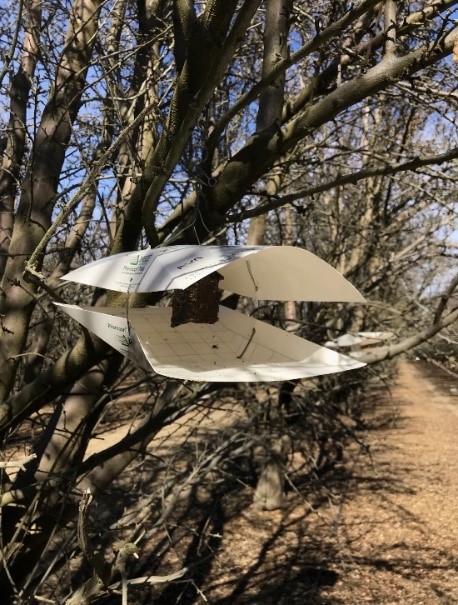 Pistachio meal-baited wing trap |
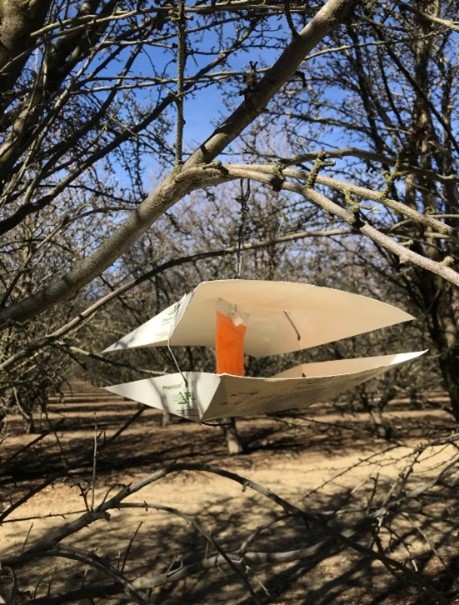 Pheromone/PPO-baited wing trap |
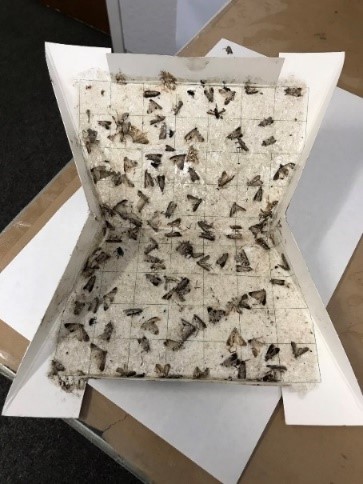 Trap containing mostly wild NOW moths |
Resources
References Cited
Bentley, W., Siegel, J.P., Holtz, B., Daane, K. 2008. “Navel Orangeworm (Amyelois transitella) (Walker) and Obliquebanded Leafroller (Choristoneura rosaceana)(Harris) as Pests of Pistachio.” Pistachio Production Manual 5th Edition. University of California Agriculture and Natural Resources. Oakland, CA. p. 179-191.
Navel Orangeworm: Almond Pest Management Guidelines on UC IPM Website. University of California Agriculture and Natural Resources: Statewide Integrated Pest Management Program. http://ipm.ucanr.edu/
Palumbo, J. D., Mahoney, N. E., Light, D. M., Siegel, J., Puckett, R. D., and Michailides, T. J. 2014. “Spread of Aspergillus flavus by Navel Orangeworm (Amyelois transitella) on Almond.” The American Phytopathological Society, Volume 98, No. 9, 2014, Pages 1194 – 1199.
Wilson, H., Burks, C. S., Reger, J. E., and Wenger, J. A. 2020. “Biology and Management of Navel Orangeworm (Lepidoptera: Pyralidae) in California.” Journal of Integrated Pest Management, Volume 11, Issue 1, 2020, 25.Upcoming Meetings
2025 Navel Orangeworm Action Committee (NOWAC) Meeting
Tuesday, July 15, 2025
Notice & Agenda
Program Contact
Additional Sources on Navel Orangeworm
Subscribe to Navel Orangeworm
Click here to subscribe



